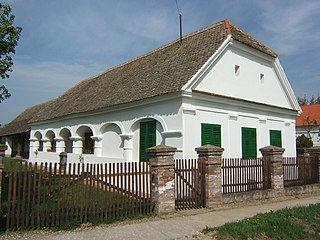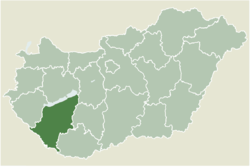
Szerencs is a town in Borsod-Abaúj-Zemplén county, Northern Hungary. It lies 35 km (22 mi) away from Miskolc, and 205 km (127 mi) away from Budapest. It has about 9,100 inhabitants.

Susedgrad Castle, or earlier also only Sused, is a ruined medieval fortress on the far-western hill of mount Medvednica, while also marking the far-western part of modern-day Zagreb, Croatia.

Barcs is a border town in Somogy County, Hungary, and the seat of Barcs District. The Drava River marks the southern boundary of the settlement.

Csurgó is a town in Somogy County, Hungary, and the seat of Csurgó District.

Nagyesztergár is a village in Veszprém county, Hungary in Zirc District.

Berzence is a village in Somogy County, Hungary, where Somogy Slovenes still live. Lankócz, Atak, Vecsernye-puszta, Szenterzsébet, Keresztfai-puszta, Perdócz-major, Garics-puszta, György-major and Vadaskerti-major are all parts of Berzence.

Kapoly is a village in Somogy county, Hungary. Political leader János Kádár originates from the village, his childhood was spent in Kapoly.

Heresznye is a village in Somogy county, Hungary.

Potony is a village in Somogy County, Hungary.

Somogysimonyi is a village in Somogy County, Hungary. It incorporates the earlier separated villages of Gardos-puszta, Irma-puszta and Angyalvár-telep.

Babócsa is a village in Somogy County, Hungary.

Somogyszentpál is a village in Somogy County, Hungary.

Bőszénfa is a village in Somogy county, Hungary.

Szulok is a village in Somogy county, Hungary.

Lakócsa is a village in Somogy County, Hungary.
Tótújfalu is a village in Somogy county, Hungary.

Szentborbás is the southernmost village of Somogy county, Hungary. Krancsevicza-puszta is part of the village.

Bogdása is a village in Baranya County, in Sellye District, west of Sellye, in the neighbourhood of Drávafok.

Patapoklosi is a village in Szigetvár district, in Baranya county, Hungary.

Ferenc Tahy de Tahvár et Tarkő, was a Hungarian–Croatian nobleman from the Tahy family, which draws its origins from Pilis County. He was known to have held the positions of royal adviser and master of the horse. His cruel treatment of serfs was one of the causes of Croatian–Slovene Peasant Revolt.




















